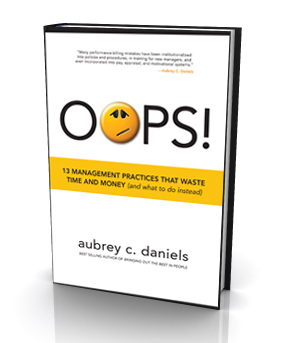Strrrrrrrrrrrretch Goals
For those unfamiliar with them, stretch goals are the practice in business, sports, and personal life of progressively increasing the targets expected of a person or team. If I am a salesperson and sell 500 widgets this month, my target next month might be set at 600.
Setting targets and striving to meet them are as old as civilization. Many people believe that stretching one’s behavior, or, in the present discussion, that of others beyond (indeed, often way beyond) the current performance is important in personal and organizational growth. Often, too, shareholders demand such activity.
At the outset, we should be clear that stretching the goal is not the goal, rather it is increasing some dimension of behavior. Several things impact how behavior changes in this context.
First, there always are limits as to what realistically can be attained. There is only so much time in a day to sell widgets, there is only so much of a market for them, and only so many can be supplied in a given time period. Furthermore, setting business goals that don’t take into account the recent responses to a business’s products or services, including economic climate and demand, can be a recipe for disaster. It is, after all, not the change in goals, but the changes in behavior that is required.
 Second is a problem Aubrey Daniels points out in his excellent little book on business practices, Oops: stretch goals too often are set without providing the support necessary to achieve them. This includes training and coaching needed to develop the behavioral skills for meeting the increased expectancy as well as other resources such as time, support personnel, equipment, and other support items. Too often, and unrealistically, training and resources remain unchanged even as performance expectancies are significantly increased. The result of this, predictably, is an unhappy boss and a fired employee.
Second is a problem Aubrey Daniels points out in his excellent little book on business practices, Oops: stretch goals too often are set without providing the support necessary to achieve them. This includes training and coaching needed to develop the behavioral skills for meeting the increased expectancy as well as other resources such as time, support personnel, equipment, and other support items. Too often, and unrealistically, training and resources remain unchanged even as performance expectancies are significantly increased. The result of this, predictably, is an unhappy boss and a fired employee.
Third, we know a lot about progressively increasing response requirements from basic research on what are called progressive-ratio (PR) schedules. These are essentially stretch goals. Under a PR schedule, a hungry rat might get its first food pellet after 5 responses on a lever. The next pellet might require 10 responses, the third 15 and so on. Eventually, the rat stops responding. The last-completed ratio before response cessation defines the breakpoint. One way to change the breakpoint is by changing the reinforcer. Delivering a better-quality food pellet or more food pellets increases the break point. Thus, one way to help people achieve stretch goals might be to make the reinforcers commensurate with the effort. Unless the reward changes with changing performance demands, behavior is likely to break down, just as it does with rats on PR schedules.
 I understand that many stretch-goal programs include neither increasingly commensurate rewards nor even acknowledgement of the increased effort. Although acknowledgement and appreciation of increased effort won’t take you far in stretching the progressive-ratio performance of a laboratory rat, it certainly has been shown to have robust effects when given as people hunker down to meet increasingly effortfull performance demands in everyday settings. Of course, even with commensurate reinforcers, a point still will be reached where the behavior won’t be sustained by them (also, there are limitations on the rewards themselves - a monetary bonus can only be so large before the cost exceeds the benefit to the organization and only so much acknowledgement or other social reinforcement can occur before its effectiveness dwindles.
I understand that many stretch-goal programs include neither increasingly commensurate rewards nor even acknowledgement of the increased effort. Although acknowledgement and appreciation of increased effort won’t take you far in stretching the progressive-ratio performance of a laboratory rat, it certainly has been shown to have robust effects when given as people hunker down to meet increasingly effortfull performance demands in everyday settings. Of course, even with commensurate reinforcers, a point still will be reached where the behavior won’t be sustained by them (also, there are limitations on the rewards themselves - a monetary bonus can only be so large before the cost exceeds the benefit to the organization and only so much acknowledgement or other social reinforcement can occur before its effectiveness dwindles.
 The absence of even acknowledgement of effort is closely related to a final weakness of many stretch-goal programs. As Aubrey points out in Oops, more often than not negative reinforcement, and not positive reinforcement, is used by those in charge to drive the increasing performance. That is, unlike the PR positive reinforcement schedule I described above, the performance is largely controlled by the avoidance of negative consequences (e.g., being labeled lazy or not up to the task or even threats of job loss or removal from the team) associated with failure to meet the goals. The consequences of such a program require no elaboration.
The absence of even acknowledgement of effort is closely related to a final weakness of many stretch-goal programs. As Aubrey points out in Oops, more often than not negative reinforcement, and not positive reinforcement, is used by those in charge to drive the increasing performance. That is, unlike the PR positive reinforcement schedule I described above, the performance is largely controlled by the avoidance of negative consequences (e.g., being labeled lazy or not up to the task or even threats of job loss or removal from the team) associated with failure to meet the goals. The consequences of such a program require no elaboration.
 Requiring more behavior over time is necessary for both personal and organizational growth. How it is required, supported, shaped, and reinforced are the keys to whether targets are likely to be met. Using these ideas from our science can convert often aversive-by-design and ultimately ineffective “stretch-goal” programs into programs that have positive outcomes for both the employees who are “stretched” and the organizations that implement them.
Requiring more behavior over time is necessary for both personal and organizational growth. How it is required, supported, shaped, and reinforced are the keys to whether targets are likely to be met. Using these ideas from our science can convert often aversive-by-design and ultimately ineffective “stretch-goal” programs into programs that have positive outcomes for both the employees who are “stretched” and the organizations that implement them.



